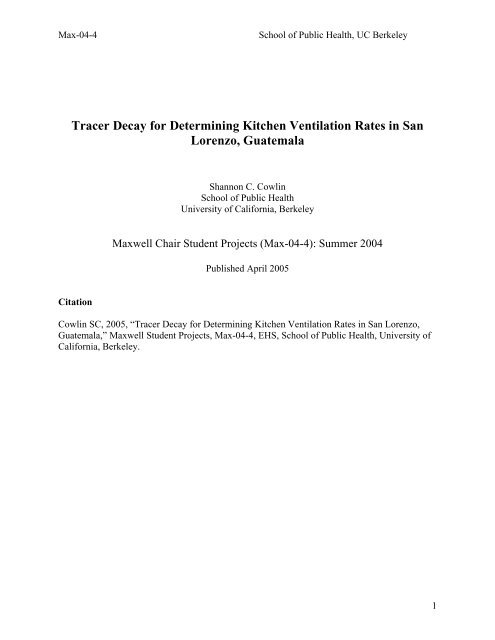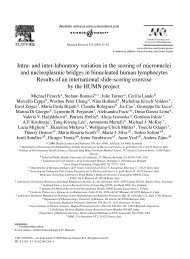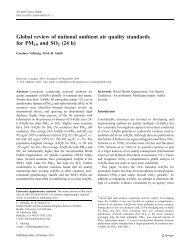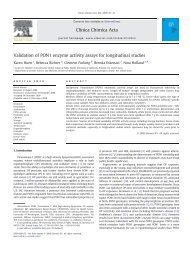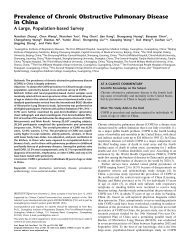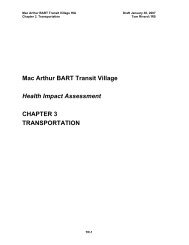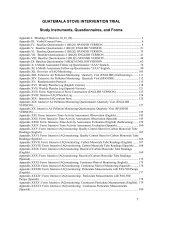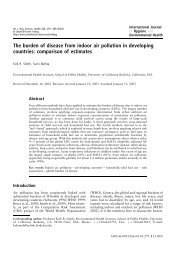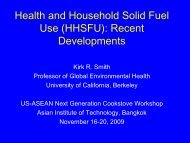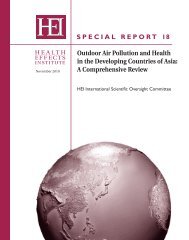Tracer Decay for Determining Kitchen Ventilation Rates in San ...
Tracer Decay for Determining Kitchen Ventilation Rates in San ...
Tracer Decay for Determining Kitchen Ventilation Rates in San ...
Create successful ePaper yourself
Turn your PDF publications into a flip-book with our unique Google optimized e-Paper software.
Max-04-4<br />
School of Public Health, UC Berkeley<br />
<strong>Tracer</strong> <strong>Decay</strong> <strong>for</strong> <strong>Determ<strong>in</strong><strong>in</strong>g</strong> <strong>Kitchen</strong> <strong>Ventilation</strong> <strong>Rates</strong> <strong>in</strong> <strong>San</strong><br />
Lorenzo, Guatemala<br />
Shannon C. Cowl<strong>in</strong><br />
School of Public Health<br />
University of Cali<strong>for</strong>nia, Berkeley<br />
Maxwell Chair Student Projects (Max-04-4): Summer 2004<br />
Published April 2005<br />
Citation<br />
Cowl<strong>in</strong> SC, 2005, “<strong>Tracer</strong> <strong>Decay</strong> <strong>for</strong> <strong>Determ<strong>in</strong><strong>in</strong>g</strong> <strong>Kitchen</strong> <strong>Ventilation</strong> <strong>Rates</strong> <strong>in</strong> <strong>San</strong> Lorenzo,<br />
Guatemala,” Maxwell Student Projects, Max-04-4, EHS, School of Public Health, University of<br />
Cali<strong>for</strong>nia, Berkeley.<br />
1
Max-04-4<br />
School of Public Health, UC Berkeley<br />
Acknowledgements<br />
Completion of this study relied heavily on the support of the field team members at MERTU <strong>in</strong><br />
<strong>San</strong> Lorenzo. I would particularly like to thank Anaite Diaz and Expedita Marroquín <strong>for</strong> their<br />
substantial contributions to make the sampl<strong>in</strong>g ef<strong>for</strong>t a success. Eduardo Canuz Castro, John<br />
McCracken, Lisa Thompson, Janet Diaz, and Gabrielle Mart<strong>in</strong>ez provided additional valuable<br />
support <strong>in</strong> <strong>San</strong> Lorenzo. I would also like to extend heartfelt thanks to Kirk Smith, who provided<br />
the access and opportunity, and The Brian and Jennifer Maxwell Endowed Chair <strong>in</strong> Public<br />
Health <strong>for</strong> fund<strong>in</strong>g the study. I would also like to thank William Nazaroff and Zohir Chowdhury<br />
<strong>for</strong> their <strong>in</strong>sights on ventilation and measurement techniques, Seema Bhangar <strong>for</strong> shar<strong>in</strong>g her<br />
experiences measur<strong>in</strong>g ventilation <strong>in</strong> India, and Asheena Khalakd<strong>in</strong>a <strong>for</strong> provid<strong>in</strong>g pre-departure<br />
support.<br />
2
Max-04-4<br />
School of Public Health, UC Berkeley<br />
1. Introduction<br />
In homes burn<strong>in</strong>g solid fuels <strong>in</strong>doors as cook<strong>in</strong>g and heat<strong>in</strong>g sources, pollution can reach levels<br />
that exceed standards set to protect human health. Indoor pollutant concentrations <strong>in</strong> these<br />
homes are largely dom<strong>in</strong>ated by the rate at which emissions are released to the <strong>in</strong>door<br />
environment and the rate at which pollutants are removed by ventilation. As such, to understand<br />
the full range of potential of <strong>in</strong>terventions to reduce human exposure, both <strong>in</strong>door emissions and<br />
ventilation need to be considered along with other factors.<br />
One approach to reduc<strong>in</strong>g human exposure to combustion byproducts is to reduce emissions<br />
from the source. This can be accomplished by chang<strong>in</strong>g fuels, such as transition<strong>in</strong>g primary use<br />
from biomass to cleaner-burn<strong>in</strong>g gaseous fuels. Other ways to reduce emissions without<br />
chang<strong>in</strong>g fuel type are to modify the stove type to promote more effective combustion and/or add<br />
a chimney to emit the bulk of emissions to the outdoor environment.<br />
The strategies discussed above to reduce human exposure do not take <strong>in</strong>to account the character<br />
of home construction, specifically the rate at which polluted <strong>in</strong>door air is exchanged with lesspolluted<br />
outdoor air. In homes with relatively low <strong>in</strong>door emission rates, pollutants can still<br />
build to unsafe levels if the ventilation rates are also low. It follows that <strong>in</strong>creas<strong>in</strong>g the<br />
ventilation rates can potentially reduce <strong>in</strong>door exposure to harmful pollutants. This can be<br />
accomplished by open<strong>in</strong>g doors or w<strong>in</strong>dows while cook<strong>in</strong>g or by leav<strong>in</strong>g open eaves <strong>for</strong> the<br />
pollutants to escape. Un<strong>for</strong>tunately, this may not be feasible <strong>for</strong> many households due such<br />
factors as weather, security, privacy, and pest control. Nevertheless, it is desirable to understand<br />
the ventilation properties of a home when assess<strong>in</strong>g human exposure.<br />
This study seeks to test the appropriateness of us<strong>in</strong>g a tracer decay method of measur<strong>in</strong>g<br />
ventilation <strong>in</strong> a rural develop<strong>in</strong>g-world sett<strong>in</strong>g. This study took place <strong>in</strong> villages near <strong>San</strong><br />
Lorenzo, Guatemala, the site of a large, randomized stove-<strong>in</strong>tervention trial<br />
(http://ehs.sph.berkeley.edu/guat/page.aspid=1 ). The participants <strong>in</strong> this study were a subset of<br />
those participat<strong>in</strong>g <strong>in</strong> the randomized trial. Measurements were made <strong>in</strong> kitchens conta<strong>in</strong><strong>in</strong>g<br />
improved plancha woodstoves, which vents most of the cookfire smoke outdoors through a<br />
chimney. These had been given to the households on a random basis to replace the open<br />
(unvented) firewood stoves traditionally used <strong>in</strong> the region.<br />
II. Description of Method<br />
The tracer decay method assumes the environment be<strong>in</strong>g studied is well approximated by a wellmixed<br />
box model. The method <strong>in</strong>volves releas<strong>in</strong>g a conserved pollutant at a known emission<br />
rate and observ<strong>in</strong>g the concentration over time.<br />
Choice of tracer gas<br />
To be appropriate <strong>for</strong> this method, the pollutant must not react to <strong>for</strong>m secondary pollutants,<br />
deposit on surfaces, or be removed <strong>in</strong> any manner other than removal by ventilation. In this<br />
study, the tracer pollutant used was carbon monoxide (CO), which meets these criteria, and,<br />
3
Max-04-4<br />
School of Public Health, UC Berkeley<br />
importantly, is easily and cheaply produced <strong>in</strong> quantity by burn<strong>in</strong>g wood or other simple solid<br />
fuels.<br />
2. Well-mixed box model with <strong>in</strong>door emission source<br />
In <strong>in</strong>door environments with <strong>in</strong>door combustion sources, the concentration of pollutants can be<br />
def<strong>in</strong>ed by employ<strong>in</strong>g mass conservation laws. For a pollutant that does not react with surfaces<br />
or other airborne species, this description is simplified. Figure 1 presents a well-mixed box<br />
model of an <strong>in</strong>door environment with non-react<strong>in</strong>g pollutant contributions from outside air and<br />
<strong>in</strong>door emissions. By def<strong>in</strong>ition, pollutant concentrations are equal <strong>in</strong> all air parcels with<strong>in</strong> this<br />
well-mixed box.<br />
Figure 1. Well-mixed box model of an <strong>in</strong>door environment with an <strong>in</strong>door<br />
emission source and pollutant contribution and removal by ventilation.<br />
C <strong>in</strong> (mass volume -1 )<br />
V (volume)<br />
Q*C out<br />
(mass time -1 )<br />
Q*C <strong>in</strong><br />
(mass time -1 )<br />
E (mass time -1 )<br />
The rate of change <strong>in</strong> pollutant mass <strong>in</strong> the <strong>in</strong>door environment presented <strong>in</strong> Figure 1 is described<br />
by (1), where C <strong>in</strong> and C out are the concentrations <strong>in</strong> the <strong>in</strong>door and outdoor air (mass volume -1 ), E<br />
is the mass emission rate from <strong>in</strong>door sources (mass time -1 ), V is the volume of the <strong>in</strong>door<br />
environment (volume), and Q is the ventilation rate (volume time -1 ).<br />
d(<br />
C<strong>in</strong>V<br />
)<br />
= E + CoutQ<br />
− C<strong>in</strong>Q<br />
(1)<br />
dt<br />
Assum<strong>in</strong>g that <strong>in</strong>door concentrations are much greater than outdoor concentrations (C <strong>in</strong> >> C out )<br />
<strong>in</strong> the presence of an <strong>in</strong>door source, the quantity (C out -C <strong>in</strong> ) is well approximated by (-C <strong>in</strong> ).<br />
Apply<strong>in</strong>g this assumption and divid<strong>in</strong>g through by V yields (2), which describes the time rate of<br />
change <strong>in</strong> concentration.<br />
dC<strong>in</strong><br />
E Q<br />
= − C<strong>in</strong><br />
(2)<br />
dt V V<br />
In the absence of emissions, (2) simplifies to (3) where all pollutant losses from the <strong>in</strong>door<br />
environment are due to removal by ventilation.<br />
dC<strong>in</strong><br />
Q<br />
= − C<strong>in</strong><br />
(3)<br />
dt V<br />
4
Max-04-4<br />
School of Public Health, UC Berkeley<br />
If Q and V are constant, (3) can be <strong>in</strong>tegrated from time t 0 = 0 to time t * to obta<strong>in</strong> an equation <strong>for</strong><br />
the <strong>in</strong>door concentration at time t * . This solution is shown <strong>in</strong> (4), where C 0 is the concentration<br />
at time t 0 .<br />
* ⎛ Q ⎞<br />
( ) = ⎜ −<br />
*<br />
C <strong>in</strong><br />
t C0<br />
exp t ⎟ (4)<br />
⎝ V ⎠<br />
The air exchange rate, often reported as air changes per hour (ACH), is the quantity (Q/V) and<br />
has the units of <strong>in</strong>verse time. If the t * and the <strong>in</strong>itial and f<strong>in</strong>al concentrations are known, the<br />
ventilation rate, <strong>in</strong> terms of ACH, can be calculated accord<strong>in</strong>g to (5).<br />
*<br />
V ln[ C0 ] − ln[ C( t )]<br />
ACH = =<br />
(5)<br />
*<br />
Q t<br />
3. Experimental Design<br />
At time of enrollment <strong>in</strong> the larger stove <strong>in</strong>tervention trial, all homes were assigned to a<br />
qualitative ventilation category based on observed home characteristics, such as construction<br />
type, open or closed eaves, and number of w<strong>in</strong>dows. The ventilation categories used were<br />
abierto, parcialmente, or cerrado (open, partially open, or closed). The project field office <strong>in</strong><br />
<strong>San</strong> Lorenzo selected potential homes <strong>for</strong> this study. Field team members visited the homes to<br />
assess will<strong>in</strong>gness to participate and to ensure that the previously assigned ventilation<br />
classifications were still applicable. The f<strong>in</strong>al study size <strong>in</strong>volved two homes from each<br />
ventilation category, and all participat<strong>in</strong>g homes had planchas. As planchas were supplied to<br />
households on a random basis, however, other household characteristics should reflect those of<br />
the community as a whole. Each home was visited on one afternoon and one morn<strong>in</strong>g, and two<br />
experiments were conducted at each visit.<br />
Equipment used <strong>in</strong>cluded 4 HOBO CO monitors (Onset Corporation, Bourne, MA), 1 Dräger CO<br />
monitor (Drägerwerk AG, Lübeck, Germany), one computer, two fire-resistant buckets, wood,<br />
and a self-support<strong>in</strong>g post with nails protrud<strong>in</strong>g at heights of 0.5, 1, 1.5, and 2 meters from the<br />
base. The HOBO monitors were launched <strong>in</strong> the morn<strong>in</strong>g prior to travel to the homes accord<strong>in</strong>g<br />
to manufacturer <strong>in</strong>structions and set to collect CO concentrations at 1-m<strong>in</strong>ute <strong>in</strong>tervals. After the<br />
first few days of experiments, the collection <strong>in</strong>terval was shortened to 15-seconds. . Upon<br />
arrival at the home, all wood, coal, and ash were removed from <strong>in</strong>side the plancha, put <strong>in</strong> one of<br />
the fire-resistant buckets, and placed outside at downw<strong>in</strong>d location. In the other fire-resistant<br />
bucket, wood was ignited to create an emission source that could easily be removed once the<br />
<strong>in</strong>door CO levels were sufficiently high. The bucket was placed at the end of the plancha on the<br />
ground.<br />
While the emissions were be<strong>in</strong>g allowed to accumulate <strong>in</strong> the kitchen, the HOBO monitors were<br />
attached to the post. The post was positioned at a lateral distance of 0.5 m from the emission<br />
source, as this is approximately the distance a cook would stand from the centerl<strong>in</strong>e of the<br />
plancha. The monitor heights of 0.5 and 1.5 meters were chosen to approximate squatt<strong>in</strong>g and<br />
stand<strong>in</strong>g breath<strong>in</strong>g heights, respectively. The two monitor<strong>in</strong>g heights of 1 and 2 meters were<br />
<strong>in</strong>cluded to collect additional <strong>in</strong><strong>for</strong>mation that might allow <strong>for</strong> better understand<strong>in</strong>g of airflow <strong>in</strong><br />
the kitchen.<br />
5
Max-04-4<br />
School of Public Health, UC Berkeley<br />
The Drager has screen that displays real-time CO concentrations. This monitor was placed<br />
approximately 1 meter from the emission source and 0.5 meters from the post. Once the<br />
emissions had been allowed to accumulate <strong>in</strong> the kitchen <strong>for</strong> approximately 30 m<strong>in</strong>utes, the<br />
Drager output was monitored until the <strong>in</strong>door CO concentration exceeded 30 ppm. At that time,<br />
the emission source was removed from the kitchen and placed at a downw<strong>in</strong>d location, and the<br />
start time of the experiment was noted. After the second experiment was complete, the wood<br />
was returned to the plancha and the data were downloaded from the monitors <strong>for</strong> analysis.<br />
4. Results<br />
For each experiment, the air exchange rates were calculated us<strong>in</strong>g 10 consecutive CO<br />
concentration measurements taken at evenly spaced time <strong>in</strong>tervals. The natural log of each CO<br />
concentration was regressed aga<strong>in</strong>st time, and the negative of the slope of this l<strong>in</strong>e is the<br />
computed air exchange rate. These values were computed <strong>for</strong> each monitor height <strong>for</strong> all<br />
experiments.<br />
Table 1 shows the mean of computed air exchange rates <strong>for</strong> each home and monitor height. Air<br />
exchange rates from the <strong>in</strong>dividual experiments are attached as Appendix A. Table 2 shows air<br />
exchange rates by household ventilation classification where the values reported are the average<br />
of all experiments and monitor heights.<br />
Table 1. Air exchange rates calculated us<strong>in</strong>g tracer decay <strong>in</strong> a well-mixed box model. ACH values are<br />
averages over all experiments and the values <strong>in</strong> parentheses are the coefficients of variation (SD/mean).<br />
ACH [hour -1 ] (COV)<br />
Monitor Height (m)<br />
<strong>Ventilation</strong> Classification and<br />
House Number 0.5 1 1.5 2<br />
Cerrado<br />
Parcialmente<br />
Casa 90 18 (0.55) 15 (0.11) 16 (0.12) 18 (0.25)<br />
Casa 328 11 (.50) 13 (0.09) 15 (0.10) 21 (0.11)<br />
Casa 247 18 (0.11) 17 (0.34) 22 (0.40) 20 (0.91)<br />
Casa 237 21 (0.50) * 16 (0.23) 15 (0.16) 17 (0.31)<br />
Abierto<br />
Casa 29 21 (0.27) 26 (0.25) 31 (0.24) 38 (0.37)<br />
Casa 37 18 (0.39) 26 (0.17) 41 (0.53) 50 (0.80)<br />
*For Casa 237, monitor height 0.5 m, the reported value is the mean of<br />
calculations from three experiments due to equipment failure. All other<br />
reported values are the mean of calculations from four experiments.<br />
6
Max-04-4<br />
School of Public Health, UC Berkeley<br />
Table 2. Mean air exchange rates by household ventilation classification.<br />
Averages are over all experiments and monitor heights.<br />
6. Discussion<br />
Household <strong>Ventilation</strong><br />
Classification<br />
ACH (COV)<br />
Abierto 29<br />
Abierto 34<br />
Parcialmente 17<br />
Parcialmente 19<br />
Cerrado 17<br />
Cerrado 15<br />
The quality of construction varied significantly between the homes, but all kitchens had open<br />
eaves. The cerrado homes tended to have more solidly constructed walls with no visible gaps,<br />
the abierto homes had significant fractions of the walls miss<strong>in</strong>g, and the walls of the<br />
parcialmente homes were between these two extremes. Though CO is a colorless and odorless<br />
gas, the wood fire also released significant amounts of particulate matter (PM), which allowed<br />
<strong>for</strong> visualization of plume dispersion. In all homes, the bulk of the plume was observed to rise<br />
and exit the home through the open eaves. The bulk plume removal via the eaves made the task<br />
of accumulat<strong>in</strong>g CO <strong>in</strong> the kitchen difficult, and it also resulted <strong>in</strong> the CO levels dropp<strong>in</strong>g below<br />
the HOBO limit of detection <strong>in</strong> under 10 m<strong>in</strong>utes, the <strong>in</strong>itially planned sampl<strong>in</strong>g duration. To<br />
ensure 10 data output read<strong>in</strong>gs <strong>for</strong> each experiment, the data-logg<strong>in</strong>g <strong>in</strong>terval was shortened to<br />
15 seconds.<br />
Observable uneven distribution of PM <strong>in</strong> the kitchen suggested that the air was not well mixed.<br />
This observation is well supported by the differences <strong>in</strong> mean air exchange rates at various<br />
monitor heights shown <strong>in</strong> Table 1. For <strong>in</strong>dividual experiments, the difference <strong>in</strong> calculated air<br />
exchange rate between adjacent monitors ranged from 0 to 56 ACH, and the average difference<br />
was 6.6 ACH.<br />
Observations and measured data support the fact that the air <strong>in</strong> the kitchens was not well mixed,<br />
which <strong>in</strong>dicates that the tracer method is <strong>in</strong>appropriate <strong>for</strong> use <strong>in</strong> homes of this and similar<br />
construction. It may be appropriate, however, to look at these measurements as effective local<br />
decay rates <strong>for</strong> air parcels at that location. This value would <strong>in</strong>clude the sum of diffuse and<br />
advective transport <strong>in</strong>to and out of that air parcel from all adjacent air parcels. Additionally, the<br />
exchange rates calculated by this method did have a tendency to follow the qualitative ventilation<br />
classification of homes, as is shown <strong>in</strong> Table 2. Though the method is <strong>in</strong>appropriate <strong>for</strong> precise<br />
quantification of ventilation <strong>in</strong> these not well-mixed environments, it may be a useful way of<br />
assess<strong>in</strong>g relative importance of ventilation <strong>in</strong> homes of this construction.<br />
7
Max-04-4<br />
School of Public Health, UC Berkeley<br />
Appendix A: Air exchange rates <strong>for</strong> all experiments and all homes<br />
Casa 29: ACH (hour -1 )<br />
Monitor Height (m)<br />
Experiment 0.5 1 1.5 2<br />
1 26 27 29 32<br />
2 21 16 23 30<br />
3 23 28 41 59<br />
4 13 31 31 31<br />
Casa 37: ACH (hour -1 )<br />
Monitor Height (m)<br />
Experiment 0.5 1 1.5 2<br />
1 20 26 28 27<br />
2 13 22 44 101<br />
3 13 32 22 11<br />
4 27 24 71 64<br />
Casa 90: ACH (hour -1 )<br />
Monitor Height (m)<br />
Experiment 0.5 1 1.5 2<br />
1 29 15 14 13<br />
2 24 13 14 14<br />
3 9 16 17 20<br />
4 10 16 18 22<br />
Casa 237: ACH (hour -1 )<br />
Monitor Ht<br />
Experiment 0.5 1 1.5 2<br />
1 14 14 12<br />
2 9 12 13 13<br />
3 26 20 17 22<br />
4 28 19 18 22<br />
Casa 247: ACH (hour -1 )<br />
Monitor Ht<br />
Experiment 0.5 1 1.5 2<br />
1 16 13 18 9<br />
2 16 12 17 7<br />
3 20 20 18 17<br />
4 19 24 35 46<br />
8
Max-04-4<br />
School of Public Health, UC Berkeley<br />
Casa 328: ACH (hour -1 )<br />
Monitor Ht<br />
Experiment 0.5 1 1.5 2<br />
1 11 12 16 22<br />
2 17 13 15 18<br />
3 4 12 13 24<br />
4 14 14 14 21<br />
9


